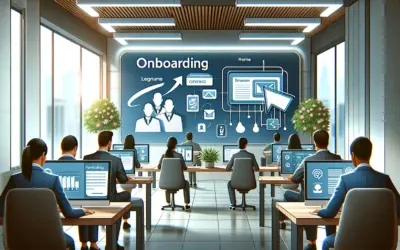The Evolution of Telework: From Novelty to Immersive Experience
Telework, once a futuristic concept, has swiftly become a mainstay in modern professional life. Its progression from a novel idea to an immersive experience is a testament to technological advancement and cultural adaptation. This metamorphosis offers insight into how our work environments have transformed, corroborating the flexibility and resilience of the workforce.
The Dawn of Telecommuting
Introduced as telecommuting in the 1970s, this early form of telework was both a reaction to environmental concerns and traffic congestion, and an exploration of the potential of emerging telecommunication technologies. Telecommuting provided the convenience of working outside the conventional office space, yet it was limited by the technology available; email was its cornerstone, tied closely with bulky desktop computers and sluggish modems.
The Advancements in Connectivity
As the internet boomed, so did the capacity for telework. The late ’90s and early ’00s saw a surge in high-speed internet availability, which, paired with portable laptops, unleashed a newfound freedom. Remote access to company networks and the birth of cloud computing redefined teleworking, propelling it beyond novelty towards necessity. Collaborative platforms began to surface, allowing distant colleagues to share documents, conduct meetings, and maintain effective communication, regardless of their physical whereabouts.
The Modern Virtual Workplace
In our current era, telework has evolved into an immersive experience. Cutting-edge virtual reality (VR) and augmented reality (AR) technologies have begun to blur the lines between physical and virtual workspaces. Immersive telepresence allows for a sensory-rich remote collaboration that rivals in-person interactions. Additionally, AI-driven assistants and automated workflows have enhanced productivity, making telework an even more attractive proposition for businesses and employees alike.
Conclusion
Understanding how telework has moved from a novelty to an immersive and integral part of our daily lives showcases our adaptability and the endless possibilities of technological innovations. With each leap forward, we redefine what it means to be «at work» and open doors to new ways of productive and collaborative employment.
Maximizing Productivity: Tools and Techniques for Effective Immersive Telework
In an ever-evolving digital landscape, telework has become a cornerstone for businesses seeking resilience and flexibility. It’s no longer just a matter of working from home; it’s about creating an immersive remote work environment that rivals the efficiency and engagement of in-office setups. This blog post delves into the essential tools and techniques that will help you maximize productivity in the realm of immersive telework.
Essential Telework Tools for Seamless Connectivity
Choosing the right tools is not just about keeping in touch. It’s about enhancing collaboration and streamlining workflows. The productivity tools we’ll explore offer robust features for video conferencing, project management, and real-time document collaboration. They’ve been honed to ensure teleworkers can stay connected and productive as if they were in the same room.
- Video Conferencing Platforms: Zoom, Microsoft Teams, and Google Meet dominate this space, providing high-quality video and audio that make virtual meetings more engaging.
- Project Management Software: Tools like Asana, Trello, and Monday.com help to keep tasks organized and transparent for the entire team, thus reducing the friction commonly associated with remote task alignment.
- Cloud-Based Suites: Google Workspace and Microsoft 365 offer cloud-based document creation, which is indispensable for real-time collaboration and version control.
Techniques to Foster Immersive Work Environments
While having the right tools is crucial, it’s equally important to apply best practices that foster a sense of immersion and presence among remote workers. Here, we uncover some proven techniques to cultivate an immersive telework culture.
- Structured Daily Check-ins: Having a regular meeting can instill a sense of normality and predictability, which can greatly enhance engagement and accountability.
- Virtual Co-Working Spaces: Platforms like Sococo and Remo offer virtual office layouts, helping to simulate a physical office environment and promote social interactions amongst team members.
- Consistent Feedback Channels: Integrate feedback tools like 15Five to keep the lines of communication open, allowing employees to share their insights and progress regularly.
Maintaining Balance and Well-being
Productivity doesn’t mean working longer hours but working smarter. It’s vital to remember that employee well-being is a key component of effective telework. Encouraging a healthy work-life balance through mindfulness apps like Headspace or Calm, and promoting regular breaks can prevent burnout and maintain a productive, happy workforce. Furthermore, employing ergonomically designed furniture and recommending regular exercise can considerably uplift an individual’s productivity at home.
The Psychology of Immersive Telework: Staying Connected in a Virtual World
As the world shifts to a more digital-centric approach to work, understanding the psychological implications of immersive telework is more important than ever. Staying connected in a virtual world poses unique challenges but also offers diverse opportunities for cultivating a vibrant remote work culture. With the advent of advanced technology, professionals can engage in a more connected, albeit virtual, work environment that demands psychological adaptability and resilience.
Embracing the New Virtual Office Space
The transition from physical to virtual office spaces has altered the way work is perceived and conducted. This alteration requires shifts in psychological constructs such as motivation, communication, and teamwork. As we embrace this new era, it’s vital to create a sense of belonging and purpose within remote teams. Strategies like virtual team-building exercises and regular video conferencing can simulate the dynamics of in-person interactions, thereby fostering a sense of community and cohesion.
Telework and Mental Well-being
While the flexibility of telework has been celebrated, it is critical to acknowledge its impact on mental well-being. The blending of work and home life often results in longer work hours and increased stress levels. Therefore, it is essential for employers to establish clear boundaries and encourage a healthy work-life balance. Regular check-ins and providing mental health resources can go a long way in ensuring employees feel supported and valued.
- Set definitive start and end times for the workday
- Encourage regular breaks and physical activity
- Offer virtual mental health support and counseling
Maintaining Effective Communication
Effective communication forms the backbone of successful telework. In a virtual setting, non-verbal cues are often lost, which can lead to misunderstandings. Employers should promote an atmosphere of open dialogue where feedback is encouraged and recognized. Tools like collaborative software and project management platforms can greatly enhance clarity and streamline work processes. Moreover, active listening and empathy must be continually developed to maintain a connected and inclusive work atmosphere.
Building a Positive Telework Culture
Creating a positive work culture remotely requires intent and strategy. Companies must be deliberate in celebrating successes and milestones in the virtual workspace to cultivate morale and motivation. Simple acknowledgments, virtual team lunches, and peer recognition programs can contribute to a positive and immersive telework experience. Through careful nurturing of company values and culture, organizations can thrive in the virtual landscape.
- Celebrate individual and team achievements virtually
- Host online social events to foster team bonding
- Promote a culture of appreciation through peer recognition programs
Enhancing Your Virtual Workspace: Tips for Personalizing Your Immersive Telework Experience
In today’s digitally-driven era, teleworking has become more than just a necessity; it’s a way of life for countless professionals. As we spend ample hours in our virtual workspaces, personalizing these spaces can bolster productivity, bolster mental well-being, and foster a deeper connection with our work. Let’s transform your digital office into a sanctuary of efficiency and comfort with these practical tips.
Strategize Your Space for Peak Performance
Your virtual workspace is a command center where every tool should serve a purpose. Begin by decluttering your digital desktop, organizing files into clearly named folders, and archiving old documents that are no longer frequently used. Utilize cloud storage solutions for better accessibility and security. Don’t overlook the power of a good wallpaper; choose an image that is calming and inspires positivity. Consider digital ergonomics: adjust your screen settings and browser layouts to reduce eye strain. By creating an ordered and serene virtual environment, you’re set for peak performance.
Infuse Personality with Customization
Infusing your workspace with personality is more than a cosmetic change—it’s about creating a place that resonates with your individuality. Utilize the flexibility of virtual tools to tailor your experience. Customize your communication platforms with themes and colors that reflect your style. Emojis, gifs, and unique notification sounds can add a light-hearted touch to your interactions. Tools like virtual backgrounds in video calls allow you to express creativity, whether it’s a serene beach landscape or your favorite city skyline. This personal flair encourages a sense of belonging in the virtual space.
Integrate Efficiency-Boosting Tools and Apps
Equip your digital workspace with tools designed to enhance efficiency. Embrace task management apps that allow you to track deadlines and set reminders. Experiment with time-tracking apps to better understand where your hours are spent, which can be a game-changer for productivity. Use browser plugins to block distracting websites during focus hours, ensuring you stay on task. Meanwhile, technical enhancements like keyboard shortcuts, text expander tools, and voice-to-text software can significantly speed up your workflow, giving you an edge in navigating your day-to-day tasks.
Facing the Challenges: Overcoming Common Obstacles in Immersive Telework
Teleworking has reshaped the landscape of the modern workplace. While the advantages are plentiful, it’s not without its hurdles. From communication breakdowns to technical difficulties, professionals navigating the telework environment encounter various challenges that require practical solutions. This article focuses on identifying the common obstacles in telework and offers actionable strategies to surmount them.
Ensuring Consistent Communication
Commencing with communication, maintaining a consistent and clear dialogue with team members is the backbone of successful telework. Remote work often translates to fewer physical meetings and more reliance on digital correspondence. Here are a few strategies to maintain a robust communication channel:
- Utilize reliable communication tools like Slack, Zoom, or Microsoft Teams for instant messaging and video conferencing.
- Schedule regular check-ins or virtual meetings to keep everyone in the loop.
- Establish a communication protocol to specify when to send an email versus when to call.
Averting Technical Glitches
Technical setbacks can thwart productivity and dampen morale. To avert such impediments:
- Invest in high-quality hardware and ensure a stable internet connection.
- Encourage team members to regularly update software, use antivirus programs, and backup data.
- Provide access to IT support for swift resolution of technological issues.
Creating a Productive Workspace
Designing an ergonomic and distraction-free workspace is fundamental for productivity. While teleworking can occasionally mean working from any location, a dedicated workspace helps in establishing work-life balance. Consider these tips:
- Choose a quiet and comfortable area of the home dedicated to work purposes only.
- Equip the workspace with ergonomic furniture and sufficient lighting.
- Remind teleworkers to take regular breaks to avoid burnout and encourage a routine that promotes work-life harmony.
Addressing Isolation and Connectivity
Isolation can be one of the more subtle, yet significant challenges faced in telework. To counter the feelings of disconnect:
- Foster a community atmosphere with social tools and virtual team-building activities.
- Encourage participation in online forums or professional networks related to work.
- Create opportunities for team members to give input and share achievements to promote a sense of inclusion and connectivity.
By embracing the aforementioned practices, we can not only face but overcome the challenges posed by immersive telework environments. The resilience and adaptability shown in doing so ensures the optimization of both productivity and personal well-being.













0 comentarios